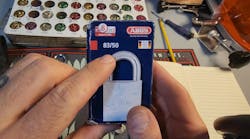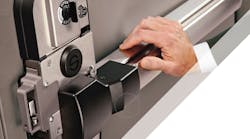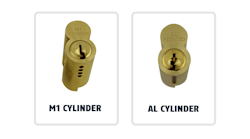Managing keys is not easy. Passively managing keys is even more difficult. In an effort to provide key management, there are key boxes, key cabinets and key sequencers. Key boxes and inexpensive key locking key cabinets provide limited key management. Many of the locks that operate these boxes and cabinets are standard cam locks whose keys can be relatively easily duplicated. Once the cabinet or key box has been opened, one or more keys can be removed without having to return them. Key cabinets require a person to monitor the borrowing and returning of the keys.
Expensive computerized key cabinets require key exchange and can also require a user code or card in order to access the “keys.” High security key cabinets are designed to manage a number of keys.
Many companies need to manage a limited number of keys where the units can be installed on the exterior of a building or in a non-secured area.
There are two important considerations for managing an important limited use key. The first is to provide access to only those individuals who should have access. The second and most important consideration is to ensure the key will be returned after the purpose has been completed. In other words, the purpose is to make sure the key does not leave with the person and when the key does, there is a way to determine who was the last user.
Passive key management becomes even more difficult when more than one person needs to have access to the key at different times.
An example of key management can be a restaurant chain that needs to have perishable foods delivered from four companies at a time when the restaurants are not open. Let us say each company must deliver to five restaurants. The companies deliver the perishables at different days and times. Providing a key to the back door for each delivery company would leave a significant number of back door keys in the hands of delivery employees and their office workers. This is because the key would have to be kept somewhere when not out on a delivery.
As an alternative, the key sequencer was developed. The basic design is a single key sequencer. With a key sequencer, one key must be left in order to obtain the “managed” key. When the “managed” key is no longer needed, returning it to the sequencer permits retrieval of the provided key. The basic key sequencer is a type of slide locking mechanism having two keyed lock cylinders or cores. Important: One cylinder/core is always secured, while the other key can be removed. When both keys are inserted and in their unlocked positions, the slide mechanism can be slid in order to remove one of the two keys.
Many key sequencers use interchangeable/removable cores, having the mechanism designed to accommodate the cores. This is because there are a significant number of companies using core-equipped locks because of the ease of eliminating keys quickly in order to securely dismiss an employee. The core can be removed and a new core combinated to a new managed or “release” key can be inserted into the sequencer. Interchangeable/removable core mechanisms are available with restricted or patented keys.
The “managed” key is inserted into one of the two cores/cylinders and rotated to the unlocked position. The “release” key is inserted into the second lock core/cylinder and rotated to the unlocked position. The slide mechanism is slid over until the “managed” key is protected by the housing and cannot be removed. The “release” key is removed, locking the slide mechanism in place and restricting the “release” key from being removed from the sequencer.
Returning to the restaurant delivery service example, each of the delivery company’s drivers carries a “release” key. Each driver carries the same key. However, each key is numbered or coded to identify the driver.
The key sequencer can be placed on the exterior of the building. The sequencer is normally constructed to prevent removal of the unit or removal of the protected key. In addition, the protected key can usually be seen.
To remove the “managed” key, each driver must insert his identifiable, patented or restricted key into the empty core/cylinder. Unlocking this core/cylinder, the driver can slide the mechanism having his key, enter the protective housing and slide the “managed” key into the open to be removed. Once removed, the door can be unlocked.
The driver’s key cannot be removed from the key sequencer because removing the “managed” key (or the driver’s key) locks the sequencer in place. To remove the driver’s key, the “managed” key must be inserted into the lock cylinder and unlocked, securing the “managed” key.
When the driver has completed his delivery, the “managed” key is inserted and the core/cylinder is unlocked. The mechanism is slid and the “release” key is removed, securing the “managed” key. The driver can make a delivery at the next location. The next delivery driver can repeat the procedure, as can each additional driver.
This eliminates the number of keys a delivery driver must carry. And when a key is lost, there is no need to rekey the entire building, just the core or cylinder used to manage the key.
Another example application can be providing employees with access into a specific area that permits one employee at a time. The employees can use their company key to unlock the sequencer’s slide mechanism (that can be Maison Master Keyed) and remove the “managed” key. This key is used to gain access into the area. Once inside, the door can be locked and no one else can gain access. When finished, the employee returns the “managed” key and removes his/her key.
Pacific Lock has introduced their PAC-KEEPER, a single key sequencer designed to be equipped with two Best/Falcon interchangeable cores up to seven pin. The PAC-KEEPER is manufactured in the U.S.A. Interchangeable cores are not included.
The core retaining slide mechanism is manufactured of solid brass. The locking mechanism incorporates two cams, one attached to each of the interchangeable core plugs at the base of the slide mechanism. Each cam is designed to operate a ball bearing in order to lock the slide mechanism in place.
The housing has raised shoulders to cover the trapped key. The housing is manufactured of investment cast stainless steel. The housing is attached to the base of the body using four screws.
The PAC-KEEPER base housing is manufactured of aluminum and has four mounting holes to secure the unit.
A key sequencer can be used to expand the capabilities of a mechanical key beyond a master key system.
Pacific Lock has several future options in development for the PAC-KEEPER. These include a magnet and sensor wired into an electronic monitoring system to indicate when the “managed” key has been removed and returned. PACLOCK is also developing a heavy-duty stainless steel shroud intended to house the PAC-KEEPER in outdoor, high risk areas.
For scenarios where you may want to “hide” the PAC-KEEPER and its trapped keys from casual viewers, PACLOCK has manufactured a KEEPER-BOX. The KEEPER-BOX is a made in the U.S.A. and is designed to house and conceal one to three PAC-KEEPERs. The KEEPER-BOX locks with any padlock.
For more information, contact your local locksmith wholesaler or Pacific Lock Company, 25615 Hercules St., Valencia, CA 91355. Telephone: 661-294-3707. Fax: 661-294-3097. Web Site: www.paclock.com.




